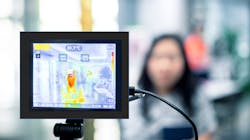FDA Safety Communication: Improper use of thermal imaging devices
The U.S. Food and Drug Administration (FDA) issued an alert to consumers, healthcare providers and other users of thermal imaging systems intended to measure human body temperature that improper use of these systems may provide inaccurate temperature readings.
These devices are also known as telethermographic systems, infrared thermographs, thermal cameras, and "fever cameras." We understand thermal imaging systems are currently being used for initial temperature assessment and triage of individuals for elevated temperatures in public areas (such as airports, workplaces, grocery stores, schools) and that such systems can be used as part of a larger approach to COVID-19 risk management, such as in combination with social distancing, wearing masks, and frequent hand washing.
A fever or higher body temperature is only one possible symptom of a COVID-19 infection. Although thermal imaging systems generally detect a high body temperature accurately when used properly, they do not detect any other infection symptoms. It is understood that not all COVID-19-positive individuals will have an elevated temperature, so temperature should not be the only sign or symptom included in an evaluation for the disease. Therefore, a temperature measurement, including a measurement obtained using a thermal imaging system, should not be solely or primarily relied upon to diagnose or exclude a diagnosis of COVID-19. A diagnostic test must be performed to determine if someone has COVID-19.
Improper use of thermal imaging systems may lead to inaccurate body temperature measurements which can present potentially serious public health risks. Such risks may include, but are not limited to, the device incorrectly detecting a normal human body temperature when a person has an elevated temperature and incorrectly assessing a person to have an elevated body temperature when they do not. These risks are more likely to be present where thermal imaging systems scan multiple individuals simultaneously. To help mitigate these risks, the FDA is providing important recommendations to consumers, health care providers and other users about the proper and improper use of these systems:
· Measure only one person's temperature at a time. To date, these systems have not been shown to be effective or accurate when used to take the temperature of multiple people at the same time. As such, they should not be used for "mass fever screening."
· Refer to Thermal Imaging Systems (Infrared Thermographic Systems/Thermal Imaging Cameras) for more information on use considerations and best practices, which include, but are not limited to:
· The accuracy of thermal imaging systems depends on careful set up and operation.
· These devices measure skin surface temperature, so the person's skin needs time to adjust to environmental changes, for example when entering a building. Some of these environmental factors are air temperature, humidity, wind, and sunlight.
· The area where you will use a thermal imaging system should be between 68-76 °F (20-24 °C). Temperatures outside this range can change skin temperature, so it may not reflect the person's internal body temperature. Additionally, the room should not have a draft (air movement) because it can change skin temperature.
· The person being assessed should not wear a hat or glasses, and their hair should be pulled away from their face. During the COVID-19 public health emergency, the FDA believes that the benefits of wearing a mask over the mouth and nose while using thermal imaging systems outweighs any potential risk of inaccurate measurements.
· Thermal imaging systems should not be used near strong light sources, such as sunlight or bright electric lighting. Also, the system should not be facing anything that can reflect light such as windows or shiny surfaces.
· High temperature readings should be confirmed with a digital thermometer such as those taken under the tongue (oral), under the arm (axillary), or in the ear (tympanic).
· Talk to your health care provider to determine the significance of a high temperature.
· Thermal imaging systems should not be used to diagnose COVID-19, but they could be considered as one method for initial temperature assessment when they are part of a larger approach to risk management.
Thermal imaging systems intended to measure a person's surface skin temperature are regulated as devices under section 201(h) of the Federal Food, Drug, and Cosmetic Act. These systems detect infrared light, which is emitted from a person's skin, and then convert that information into a skin temperature reading. The skin temperature might then be used to estimate the temperature at a reference body site (for example, mouth and ear).
Thermal imaging systems have not been shown to be accurate when used to take the temperature of multiple people at the same time and should not be used for "mass temperature screening." The accuracy of these systems depends on careful set-up and operation as well as proper preparation of the person being evaluated. Improper use of these devices may lead to an inaccurate skin temperature reading. The risks associated with inaccurate temperature measurement may include missing someone with an elevated skin temperature and incorrectly assessing a person to have an elevated skin temperature when they do not.
The FDA issued the Enforcement Policy for Telethermographic Systems During the Coronavirus Disease 2019 (COVID-19) Public Health Emergency in April 2020 to help expand the availability of thermal imaging systems and mitigate thermometer shortages during the public health emergency. The guidance sets forth an enforcement policy that is intended to apply to all thermal imaging systems that are intended for medical purposes for the duration of the public health emergency related to COVID-19 and provides recommendations regarding performance and labeling of such systems.
The FDA is aware of some firms marketing unapproved, uncleared, and unauthorized thermal imaging devices intended to measure human body temperature, including measuring multiple individuals' temperatures simultaneously. The FDA has issued several related Warning Letters and may take other action, as appropriate. The FDA will continue to monitor this issue and keep the public informed if significant new information becomes available.
